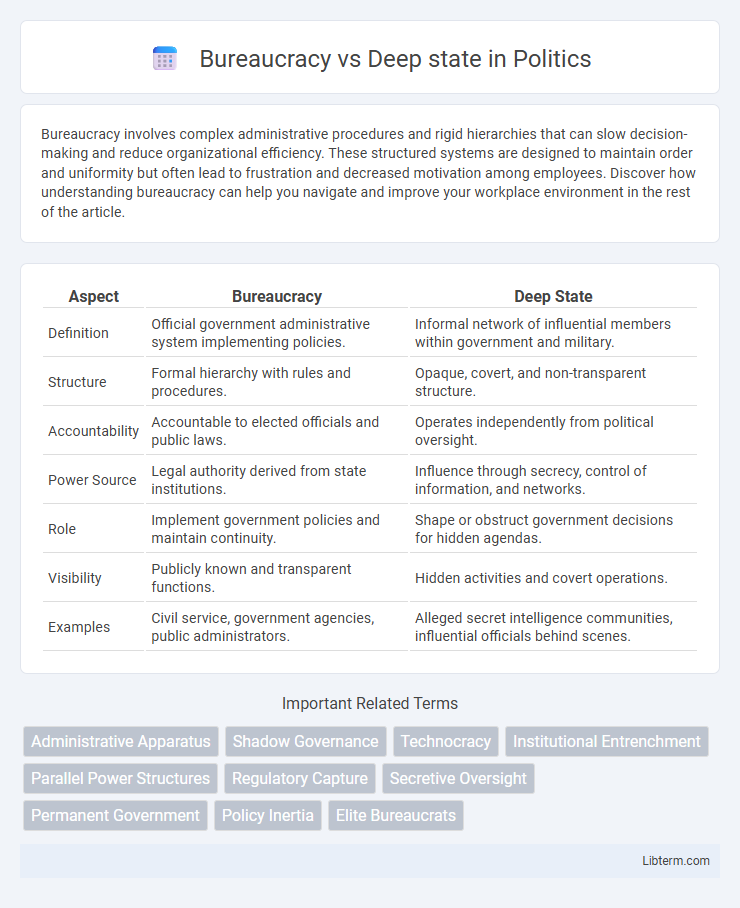Bureaucracy involves complex administrative procedures and rigid hierarchies that can slow decision-making and reduce organizational efficiency. These structured systems are designed to maintain order and uniformity but often lead to frustration and decreased motivation among employees. Discover how understanding bureaucracy can help you navigate and improve your workplace environment in the rest of the article.
Table of Comparison
| Aspect | Bureaucracy | Deep State |
|---|---|---|
| Definition | Official government administrative system implementing policies. | Informal network of influential members within government and military. |
| Structure | Formal hierarchy with rules and procedures. | Opaque, covert, and non-transparent structure. |
| Accountability | Accountable to elected officials and public laws. | Operates independently from political oversight. |
| Power Source | Legal authority derived from state institutions. | Influence through secrecy, control of information, and networks. |
| Role | Implement government policies and maintain continuity. | Shape or obstruct government decisions for hidden agendas. |
| Visibility | Publicly known and transparent functions. | Hidden activities and covert operations. |
| Examples | Civil service, government agencies, public administrators. | Alleged secret intelligence communities, influential officials behind scenes. |
Understanding Bureaucracy: Definition and Functions
Bureaucracy is a structured system of administration characterized by hierarchical organization, formal rules, and division of labor designed to implement government policies efficiently. It functions to ensure consistent application of laws, manage public services, and facilitate decision-making processes within governmental or organizational frameworks. Understanding bureaucracy involves recognizing its role in maintaining order, stability, and predictability in complex institutions while differentiating it from the covert influence associated with the deep state.
What is the Deep State? Origins and Key Concepts
The Deep State refers to a covert network of influential members within government agencies, intelligence services, and military institutions that operate independently of elected officials to shape national policy. Originating from political theories about shadow governance, the concept highlights the tension between official bureaucratic functions and hidden power structures that resist democratic accountability. Key concepts include its clandestine operations, permanence beyond electoral cycles, and its role in steering long-term strategic interests irrespective of public mandate.
Historical Evolution: Bureaucracy vs Deep State
The historical evolution of bureaucracy traces back to ancient civilizations like Egypt and Mesopotamia, where structured administrative systems were established to manage state affairs and public services efficiently. The concept of the deep state emerged more recently, often linked to the Cold War era, describing a network of entrenched officials within the military, intelligence agencies, and civil service who operate independently of elected leadership. While bureaucracy is characterized by formalized rules and hierarchical procedures, the deep state implies covert influence and hidden agendas that challenge democratic accountability.
Structural Differences: Organization and Power Dynamics
Bureaucracy functions as a formal organizational system characterized by hierarchical structure, clear roles, and regulated procedures designed for efficient governance and policy implementation. The deep state operates as an informal network of influential actors within or outside official institutions, exerting covert control and power beyond public accountability. Structural differences highlight bureaucracy's transparent chain of command versus the deep state's opaque, decentralized power dynamics often driven by hidden agendas.
Roles in Policy-Making: Bureaucratic Influence vs Hidden Agendas
Bureaucracy plays a formal role in policy-making through implementation, regulation, and expert advice within government institutions, ensuring the continuity and efficiency of public administration. The deep state, by contrast, operates through covert networks and unelected actors seeking to influence or subvert policy decisions based on hidden agendas and long-term interests beyond public oversight. This distinction highlights the transparent, rule-bound influence of bureaucrats versus the secretive, often unaccountable power wielded by deep state elements.
Accountability and Transparency Issues
Bureaucracy struggles with accountability due to hierarchical complexity, often resulting in opaque decision-making processes and diminished transparency. The Deep State exacerbates these issues by operating covertly within government structures, undermining democratic oversight and public scrutiny. Both entities challenge effective governance by limiting access to information and obstructing mechanisms designed to hold power accountable.
Public Perception: Legitimacy, Trust, and Criticism
Public perception of bureaucracy often centers on its perceived legitimacy as an essential administrative structure, fostering moderate trust due to standardized procedures and accountability mechanisms. In contrast, the deep state is viewed with suspicion and criticism, seen as a secretive network wielding unelected power that undermines democratic institutions and erodes public trust. The legitimacy of bureaucracy is reinforced by transparency and legal oversight, whereas the deep state's opaque operations provoke widespread skepticism and concerns about unchecked influence.
Case Studies: Bureaucratic Systems vs Deep State Allegations
Case studies of bureaucratic systems reveal structured, rule-based governance emphasizing transparency and accountability, as seen in countries like Germany and Sweden, where administrative processes follow clear legal frameworks. In contrast, deep state allegations often arise in nations such as Turkey and Egypt, where unelected entities purportedly manipulate political power behind the scenes, undermining formal institutions. Comparative analysis highlights how bureaucratic efficiency and deep state opacity produce divergent impacts on policy implementation and public trust.
Impact on Democracy and Governance
Bureaucracy provides structured administrative support essential for implementing policies within democratic governance, ensuring consistency and accountability. The deep state, characterized by covert networks within government institutions, can undermine transparency and democratic oversight by exercising power outside elected authority. Both entities influence governance, but while bureaucracy operates within formal legal frameworks, the deep state poses risks to democratic legitimacy and institutional trust.
Navigating Reforms: Balancing Bureaucratic Efficiency and Oversight
Navigating reforms requires balancing bureaucratic efficiency with robust oversight to prevent the entrenchment of a deep state, where unelected officials wield disproportionate control over policy. Effective reform strategies emphasize transparency, accountability, and streamlined processes within bureaucracies to enhance performance while curbing hidden power dynamics. Integrating technology-driven solutions and fostering interagency collaboration also support responsive governance without sacrificing checks and balances.
Bureaucracy Infographic

 libterm.com
libterm.com